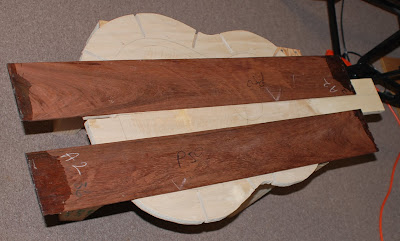The parts of the guitar are known by various names. In the U.S. we typically refer to the wood between the top and back as 'sides'. In the U.K. they are called 'ribs', which makes just as much sense.
The tricky part here (there's always a tricky part) is to bend them to the proper shape without breaking them. They have to be thin enough to bend, but not so thin that they are weak and unstable.
These are the sides as recieved from the wood supplier. The need to be thinned a lot, but this has to be done carefully so the wood is not damaged in the process (the power planer is not an option).
After thinning...
In this case these sides had enough extra width to allow sawing some thin strips to use for the binding (you'll see that used much later). The wood, as recieved, is not always wide enough to provide bindings but in this case I was lucky.
Some final thinning and smothing before bending...
Since I had the bindings cut, I went ahead and glued on some veneer strips for decoration. Here, the veneer is being scraped level with the binding.
back to the sides... there are two approaches to go about getting them bent into the desired shape: freehand bending using a 'bending iron' (a sort of circular or oblong shaped metal pipe with a heat source), or a bending jig - bending the wood over a form. Here, I'm using a bending jig with a heat blanket to supply the heat.
Once clamped into the form, the side is allowed to cool, and remains in the form for several hours to prevent springback of the bent wood.
Next Post:
Fitting and Attaching the Sides,
Tail Block, and Linings







No comments:
Post a Comment